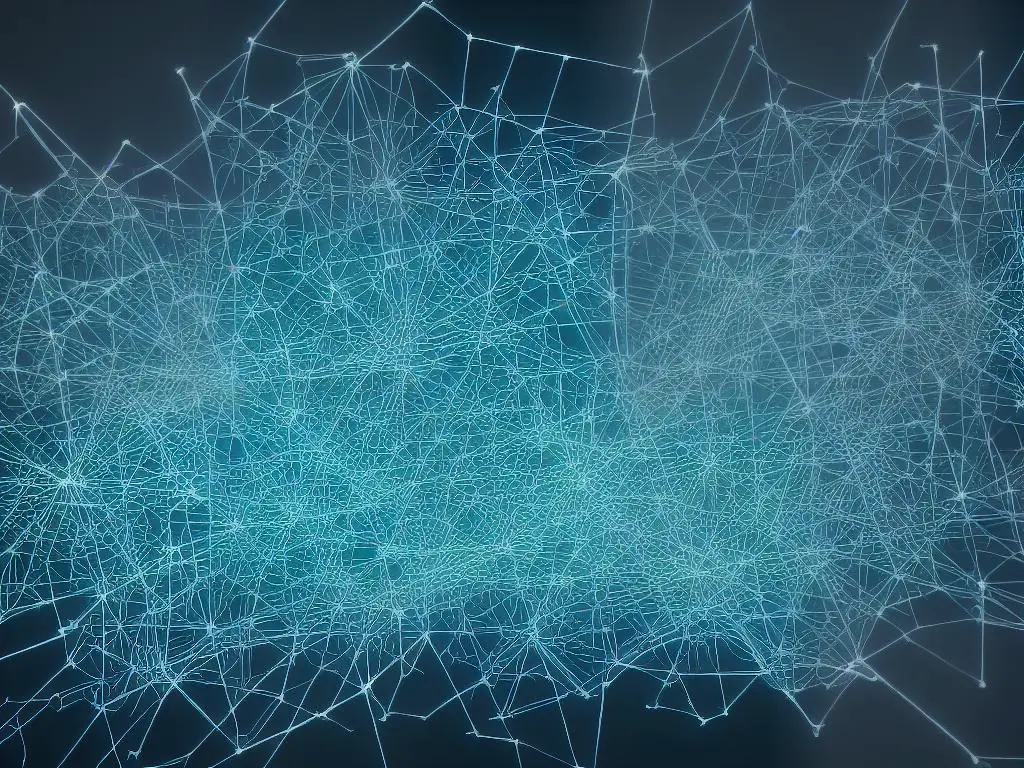Artificial Neural Networks (ANNs) have emerged as a powerful tool for solving complex problems and mimicking the human brain’s ability to process and transmit information. By studying and mastering this remarkable technology, enthusiasts and hobbyists can unlock new opportunities and improve their understanding of artificial intelligence.
This article delves into the world of ANNs, exploring various types, training and optimization techniques, common challenges faced, real-world applications, and popular tools and frameworks used in the field.
Understanding Neural Networks
Table of Contents
One of the fundamental aspects of artificial neural networks is their biological inspiration: the human brain and its intricate network of neurons. Neurons are specialized cells that process and transmit information through electrical and chemical signals.
Similarly, artificial neural networks comprise interconnected nodes, called artificial neurons, that mimic the functionality of biological neurons. The understanding of these connections and their immense ability to process information is essential for comprehending how artificial neural networks operate.
An artificial neural network (ANN) consists of multiple layers, including an input layer, one or more hidden layers, and an output layer. Each layer comprises various neurons, and these neurons are connected to the neurons of adjacent layers through weighted links.
The input layer receives data for processing, whereas the output layer provides the final result or predictions. The hidden layers, which lie between the input and output layers, are responsible for the actual learning and transformations. During the learning process, weights are adjusted to minimize the error between the generated output and the desired output.
The fundamental operation of artificial neural networks involves the processing and relaying of information through these interconnected neurons.
The input neurons receive data or signals in the form of numerical values, and through linear combinations and weighted connections, these values propagate through the network. At each neuron, the sum of the incoming values is calculated, and this sum passes through an activation function, which determines the neuron’s output.
Activation functions play a crucial role in the neural network’s performance and learning abilities. They introduce non-linearity into the model, allowing the network to learn complex relationships between features and handle various tasks, such as object detection, image recognition, and language translation.
Common activation functions include the sigmoid, hyperbolic tangent (tanh), and rectified linear units (ReLU), among others. The choice of an activation function depends on the specific problem and data set, as different activation functions can impact the model’s accuracy and convergence rate during training.
Artificial neural networks are a powerful tool for enthusiasts and hobbyists seeking to learn about and experiment with machine learning. One of the essential aspects of such networks is the backpropagation algorithm, which serves as the primary mechanism for adjusting the weights of the connections in the network during the training process.
As the network receives training examples and generates output predictions, the backpropagation algorithm calculates the error between the predicted outputs and the actual outputs. This error is then used to modify the connection weights iteratively, improving the network’s performance over time.
Understanding these underlying principles and mechanisms will enable you to better appreciate and grasp the remarkable capabilities of artificial neural networks.

Types of Neural Networks AgentGPT Uses
Feedforward neural networks, the most common type of artificial neural network, are an excellent starting point for enthusiasts and hobbyists. These networks consist of an input layer, one or more hidden layers, and an output layer. In feedforward networks, information flow occurs in one direction – from the input layer to the output layer – with no loops or cycles.
Each neuron in a layer receives input from previous layers, processes it, and passes the result to the next layer. This architecture enables feedforward networks to approximate complex functions and make predictions.
Their simplicity and ease of implementation make them suitable for a wide range of applications, including regression, classification, and pattern recognition. However, feedforward networks do not capture temporal patterns or learn from sequential data, which may limit their applicability depending on your particular area of interest.
Recurrent neural networks (RNNs), on the other hand, are designed to address the limitations of feedforward networks by introducing connections that loop back on themselves. This feedback mechanism allows RNNs to maintain a hidden state, which enables them to capture temporal dependencies in sequential data.
This inherent ability to model long-term dependencies makes RNNs powerful tools for time-series analysis, natural language processing, and speech recognition. However, RNNs may suffer from issues like vanishing or exploding gradients that can destabilize training, especially with long sequences.
To overcome these challenges, specialized architectures like long short-term memory (LSTM) and gated recurrent units (GRU) have been developed to effectively mitigate these issues and ensure stable learning.Convolutional neural networks (CNNs) are a specific type of neural network designed to process grid-like data, such as images or video frames.
The fundamental building blocks of CNNs are convolutional layers, which use sets of learnable filters to identify local patterns in input data. These filters are slid across the input data, applying convolutional operations to identify relevant features. CNNs also include pooling layers to reduce spatial dimensions and improve computational efficiency.
Key advantages of CNNs include their ability to learn hierarchies of features, which help capture complex visual patterns, and their invariance to changes in scale, rotation, and translation. This makes CNNs particularly well-suited for tasks like image classification, object detection, and semantic segmentation.Another type of neural network is the autoencoder, which is an unsupervised learning model that seeks to reproduce its input at the output layer.
Autoencoders typically consist of an encoder that maps the input data to a lower-dimensional latent space and a decoder that reconstructs the original input from the latent representation. The goal of training an autoencoder is to minimize the reconstruction error, forcing the model to learn a compact and meaningful representation of the input data.
Autoencoders have been widely used for dimensionality reduction, feature extraction, data compression, and unsupervised pre-training for deep neural networks.
Sparse autoencoders are a variation of autoencoders that include a sparse penalty term, encouraging the activation of only a small number of neurons. With this connectivity constraint, sparse autoencoders generate more interpretable and compact feature representations.
This makes them valuable for applications like image denoising, feature selection, and unsupervised clustering. Additionally, advancements in deep learning have led to the development of more sophisticated models, such as adversarial autoencoders and variational autoencoders.
These integrate Bayesian techniques and generative modelling, enhancing unsupervised learning capabilities.

Training and Optimization of AgentGPT Neural Networks
Smoothly transitioning into the training and optimization aspect, these components are critical in the development and success of artificial neural networks (ANNs), and learning methods are essential. For instance, backpropagation stands as the most popular approach.
Backpropagation involves adjusting the weights and biases of a neural network to minimize the error between its predicted outputs and the actual target values. Through repeated updates to these parameters in a series of iterations, the model’s accuracy improves gradually over time.
Optimization techniques are employed to improve the effectiveness and efficiency of the training process. For instance, the concept of the learning rate is pivotal in adjusting the weights of a neural network during the backpropagation process.
A learning rate controls the size of the steps taken in the direction of the minimal error within the weight space. If the learning rate is too large, the model may overshoot the optimal weight configuration, but if it’s too small, the process becomes slow and may not converge to a satisfactory solution. Fine-tuning the learning rate can significantly impact the model’s performance and training time.
Another optimization technique is gradient descent, an algorithm used to minimize the loss function by iteratively updating the model’s parameters.
Gradient descent uses the gradients of the loss function concerning the parameters to direct the updates, thus ascending the direction of the steepest descent. Several variants of gradient descent exist, such as stochastic gradient descent (SGD) and mini-batch gradient descent, each with its advantages and drawbacks. These variants help strike a balance between computational efficiency and accuracy of the weight updates.
Regularization techniques are also essential in the optimization process, as they help prevent overfitting. Overfitting occurs when a neural network becomes too complex and adapts to the training data’s noise, deteriorating its performance on unseen data.
Regularization methods, such as L1 and L2 regularization, add a penalty term to the loss function based on the model’s weights. This penalty discourages overly large weights or excessive complexity, making the model more general and better suited to handling new data.
Advanced optimization algorithms, such as AdaGrad, RMSprop, and Adam, can be employed to enhance the training efficiency of Artificial Neural Networks (ANNs) for enthusiasts and hobbyists. These methods adapt the learning rate during training, providing a more dynamic and tailored optimization process.
By addressing the limitations of standard gradient descent approaches, these advanced algorithms can significantly improve neural network performance and reduce training time, ultimately resulting in a more robust and efficient artificial neural network.

Common Problems and Solutions
However, one common issue faced while working with ANNs is overfitting. Overfitting occurs when a model becomes too complex and captures noise in the training data, resulting in poor performance on new, unseen data.
Conversely, underfitting is a problem when a model is too simplistic and cannot capture the underlying patterns in the dataset, also leading to poor generalization to new data. By understanding and addressing these issues, enthusiasts and hobbyists can create better-performing ANNs that are capable of handling various tasks and challenges.
One strategy to mitigate overfitting is using dropout layers in the neural network’s architecture. Dropout is a regularization technique that randomly drops out neurons during training. This prevents the model from relying too heavily on individual neurons and encourages it to learn more robust and redundant representations of the data.
By helping the model avoid relying on just a few specific neurons, dropout can prevent the model from overfitting and learning patterns that may not translate well to unseen data.
Another technique to combat overfitting is early stopping, which involves stopping the training process of an ANN when the model’s validation loss stops improving or begins to increase as the training loss continues to decrease.
This technique allows the network to ‘stick’ to the best model it has hypothesized and prevents it from continuing to learn extraneous noise. Early stopping can be implemented easily in many libraries used for training ANNs, such as TensorFlow, and makes models more generalizable by ensuring they do not overfit the training data.
One can also address underfitting by using cross-validation, which involves partitioning the dataset into several subsets and iteratively training and evaluating the model on different subset combinations.
This technique ensures that the ANN is exposed to a more diverse set of data and can help identify if the model is too simplistic. In addition, if underfitting persists, adjusting the model’s architecture and increasing its complexity by adding layers or neurons may help learn the underlying patterns in the dataset more effectively.
Working with artificial neural networks (ANNs) can be both exciting and challenging, especially for enthusiasts and hobbyists who aim to become skilled in this field. Becoming proficient in ANNs typically involves experimenting with hyperparameters, such as learning rate or batch size, to find the optimal values that yield good performance.
A common technique employed is grid search, which evaluates a range of hyperparameter values to determine the best combination for a specific dataset. By utilizing these techniques, hobbyists can overcome common ANN problems and steadily grow their expertise in designing and implementing neural networks.

ANN Applications and Agent GPT Case Studies
A notable application of artificial neural networks (ANNs) is in the realm of image recognition, which has fueled advancements in areas like facial recognition systems and autonomous vehicles. In facial recognition, ANNs can classify and identify faces by analyzing patterns in facial features, significantly enhancing the accuracy compared to traditional methods.
Simultaneously, autonomous vehicles harness ANN-driven image recognition for real-time identification of roads, pedestrians, and obstacles crucial for safe navigation. Incorporating image recognition systems based on ANNs has led to remarkable improvements in security and driver assistance systems, streamlining user experiences and reducing accident rates.
Another exciting application of ANN is in natural language processing (NLP), where it has revolutionized tasks such as sentiment analysis, text generation, and translation. One popular case study is the development of OpenAI’s GPT-3, a state-of-the-art language model leveraging deep learning techniques. GPT-3 has demonstrated an impressive ability to generate human-like text and understand context, opening up possibilities for advanced AI-driven chatbots, content generation, and language-based applications.
Despite its success, GPT-3 also showed limitations in interpreting and providing sensible answers to some ambiguous queries, highlighting areas in which further research and development are necessary.Artificial neural networks have also been instrumental in the field of medical diagnostics, contributing to significant advancements in disease detection and treatment planning.
One such example is the use of ANN in diagnosing diabetic retinopathy, a leading cause of blindness, by analyzing retinal images. The ability to detect the disease in its early stages allows healthcare providers to implement timely treatment plans, ultimately reducing the risk of severe vision loss. ANN-based diagnostic tools have similarly been applied to various other medical applications, such as detecting tumors through medical imaging or predicting patient outcomes based on historical data.
In the world of finance, ANN applications have proven to be valuable in areas like credit scoring, fraud detection, and algorithmic trading. Banks and financial institutions have started to incorporate ANN into credit scoring models to assess the creditworthiness of clients more accurately and quickly.
These models analyze extensive and multi-dimensional financial data to predict the probability of default or bankruptcy. Similarly, fraud detection systems that employ ANN can recognize patterns indicative of fraudulent transactions, enhancing the security of financial operations.
Algorithmic trading firms harness the predictive capabilities of ANN to optimize trading strategies to maximize profits while minimizing risks.As climate change becomes an increasingly critical issue, artificial neural networks (ANNs) have demonstrated their potential for aiding in environmental conservation efforts. ANN-based models have been employed to predict air pollution levels, monitor deforestation, and identify potential sites for renewable energy installations.
Such models help policy-makers and environmental agencies to track the impact of human activities on the environment and devise sustainable strategies to mitigate these effects. Moreover, ANN-based models can optimize energy consumption patterns and adjust energy distribution networks to promote energy efficiency in households and public spaces.
Overall, the versatility and adaptability of artificial neural networks have brought significant advancements across various sectors, contributing to improved decision-making, efficiency, and problem-solving.

Tools, Libraries, and Frameworks
Considering the growing importance of ANNs in modern environmental and technological applications, understanding and mastering these computational models is crucial for enthusiasts and hobbyists. TensorFlow, developed by the Google Brain Team, is one of the most popular open-source libraries for numerical computation and large-scale machine learning.
It was specifically built for handling complex machine learning tasks, such as training deep artificial neural networks. With its flexible architecture, TensorFlow is not only capable of running on CPUs and GPUs but also offers support for distributed computing, making it a go-to choice for large-scale projects.
TensorFlow has a suite of visualization tools called TensorBoard that enables users to better understand and visualize the architecture, training, and performance of an artificial neural network. Aspiring ANN developers can leverage TensorFlow and related resources to become proficient in implementing and utilizing these groundbreaking computational models.
Keras, on the other hand, is a high-level neural network API written in Python and features easy-to-use programming constructs. It is capable of running on top of other low-level libraries, such as TensorFlow and Microsoft Cognitive Toolkit.
This makes Keras an excellent choice for enthusiasts and hobbyists looking for a more user-friendly platform to develop and experiment with artificial neural networks. Keras offers various pre-trained AgentGPT AI models, which can be used for transfer learning, and a user-friendly interface for building and training custom neural network models.
PyTorch, developed by Facebook’s AI Research lab, is another popular deep learning framework that offers greater flexibility and speed than TensorFlow. PyTorch’s dynamic computation graph and “eager execution” allow developers to easily make changes and debug neural network architectures.
It offers rich APIs for creating neural network layers, activation functions, and loss functions, which are essential components in building artificial neural networks. PyTorch is popular among researchers and developers because of its simplicity, easy debugging capabilities, and seamless integration with other Python libraries like NumPy and SciPy.
One of the best ways to get started with these tools and libraries is by following step-by-step tutorials and learning from the numerous resources available online. Most of these frameworks have detailed documentation and community-driven forums that offer practical advice and examples of how to create and train neural networks using different architectures and datasets.
Furthermore, these libraries and frameworks are regularly updated, ensuring that users have access to the latest and most efficient techniques in deep learning and neural network development.
In conclusion, TensorFlow, Keras, and PyTorch are some of the widely used tools, libraries, and frameworks for creating, training, and deploying artificial neural networks. Each framework has its unique features and advantages, with TensorFlow offering scalability, Keras focusing on user-friendliness, and PyTorch providing flexibility.
Engaging with these technologies and learning from the abundant online resources will equip enthusiasts and hobbyists with the necessary skills to develop advanced artificial neural networks and contribute to the ever-evolving field of deep learning.

Throughout this article, we have navigated the fascinating realm of artificial neural networks embedded in AgentGPT AI, examining their fundamental principles, structures, and functions. The exploration of different network types, training and optimization methods, common issues, and practical applications has provided a solid foundation for enthusiasts and hobbyists to further develop their skills in ANNs.
Equipped with the knowledge of essential tools, libraries, and frameworks, readers are now better prepared to embark on their own journey, experimenting and implementing neural networks with confidence and success.

I’m Dave, a passionate advocate and follower of all things AI. I am captivated by the marvels of artificial intelligence and how it continues to revolutionize our world every single day.
My fascination extends across the entire AI spectrum, but I have a special place in my heart for AgentGPT and AutoGPT. I am consistently amazed by the power and versatility of these tools, and I believe they hold the key to transforming how we interact with information and each other.
As I continue my journey in the vast world of AI, I look forward to exploring the ever-evolving capabilities of these technologies and sharing my insights and learnings with all of you. So let’s dive deep into the realm of AI together, and discover the limitless possibilities it offers!
Interests: Artificial Intelligence, AgentGPT, AutoGPT, Machine Learning, Natural Language Processing, Deep Learning, Conversational AI.


